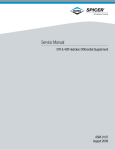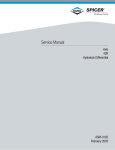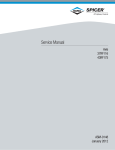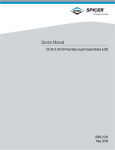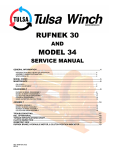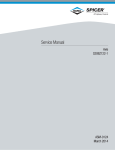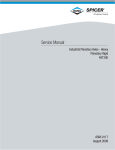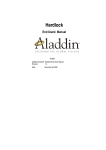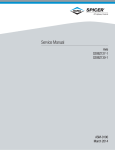Download 37R Hydraloc D&C Service Manual (Final)
Transcript
Service Manual 36R Hydraloc Differential Axle ASM-0159 September 2009 36R Hydraloc Differential Service Manual FOREWORD This manual has been prepared to provide the customer and maintenance personnel with information and instructions on the maintenance and repair of Dana Products. Extreme care has been exercised in the design and selection of materials and manufacturing of these units. The slight outlay in personal attention and cost required to provide regular and proper lubrication, inspection at stated intervals, and such adjustments as may be indicated will be reimbursed many times in low cost operation and trouble free service. In order to become familiar with the various parts of the product, it’s principle of operation, troubleshooting, and adjustments it is urged that mechanics study the instructions in this manual carefully and use it as a reference when performing maintenance and repair operations. Whenever repair or replacement of component parts is required, only Dana approved parts as listed in the applicable parts manual should be used. Use of “will fit” or non-approved parts may endanger proper operation and performance of the equipment. Dana does not warrant repair, replacement parts or failures resulting from the use of parts which are not supplied or approved by Dana. Important: Always furnish serial and model numbers when ordering parts. SAFETY PRECAUTIONS To reduce the chance of personal injury and/or property damaged, the following instructions must be carefully observed. Proper service and repair are important to the safety of the service technician and the safe, reliable operation of the machine. If replacement parts are required the part must be replaced with a Dana specified replacement part. Do not use a replacement part of lesser quality. The service procedures recommended in this manual are effective methods of performing service and repair. Some of these procedures require the use of purpose designed tools. Accordingly, anyone who intends to use a replacement part, service procedure or tool which is not recommended must first determine that neither his safety or the safe operation of the machine will be jeopardized by the replacement part, service procedure or tool selected. It is important to note that this manual contains various “Cautions and Notices” that must be carefully observed in order to reduce the risk of personal injury during service or repair. Improper service or repair may damage the unit or render it unsafe. It is important to understand that these “Cautions and Notices’ are not exhaustive. It is impossible to warn of all possible hazardous consequences that may result from following or failing to follow these instructions. 1 36R Hydraloc Differential Service Manual TABLE OF CONTENTS 1. 2. 3. 4. 6. 7. 8. 9. 10. 11. 12. 13. 14. 15. Forward and Caution Table of Contents Bearing Heating and Freezing Guidelines Cleaning and Inspection Fastener Torque Chart Plug and Elastic Stop Nut Torque Charts Recommended Lubricants Gear Tooth Contact Chart – LH Gear Tooth Contact Chart – RH Cross Section Illustration Inner Pinion Bearing Staking Pinion Depth Setting Procedure Differential Assembly Exploded View Differential Assembly Parts Description DISASSEMBLY 16. 16. 19. Differential Assembly Removal Differential and Carrier Disassembly Differential Disassembly REASSEMBLY 21. Differential Reassembly 25. Pinion Bearing Setting Procedure 27. Ring Gear and Pinion Backlash Setting Procedure 27. Ring Gear to Pinion Distance Setting Procedure 29. Differential Installation 2 36R Hydraloc Differential Service Manual BEARING HEATING AND FREEZING GUIDELINES Bearings often must be cooled or heated to aid in assembly or removal. Since temperature extremes can cause permanent bearing metallurgical damage, it is important to take proper precautions and use correct methods when heating and cooling bearings. Cups that are to be assembled in hubs or housings with a press fit may be shrunk in a deep freeze unit. Standard class bearings should not be cooled below -65° F (-54° C). In addition to cooling the bearing cup, in some instances it may be necessary to heat the housing. To control temperature, is best to use a thermostat along with a freezer unit or a properly calibrated thermometer. If a suitable freezer or thermometer is not available, your Timken service representative can suggest liquid combinations that freeze the bearing cup at the optimal temperatures. Regardless of the method, check the cup’s final seating against the housing shoulder with feeler gauges. Take extreme care that standard product bearings are never heated above 149° C [300° F]. If bearings are heated above this temperature, their metallurgical structure may soften, rendering them unsuitable for use. There are a number of recommended methods for heating bearings. Electric ovens or electrically heated oil baths may be used, but only when accompanied by proper thermostatic control. If you use a hot plate to heat the oil, never rest bearings directly on the bottom of the pan. Instead, protect bearings from the heat source with a simple wire screen holder or similar device. Use heat-resistant gloves to handle heated cones. Hold the hot cone solid against the cold shoulder on the shaft until the cone grabs on to the shaft. The hot cone will pull away from the cold shoulder unless it is held in position. Use .002 [.05 mm] feeler gages to make sure the cone is fully seated against the shoulder after the parts are cooled. Many loose bearing settings (excessive end play) are caused by an unseated cone working back against the shoulder in service. 3 36R Hydraloc Differential Service Manual CLEANING AND INSPECTION CLEANING Clean all parts thoroughly using solvent type cleaning fluid. It is recommended that parts be immersed in cleaning fluid and agitated slowly until parts are thoroughly cleaned of all old lubricants and foreign materials. CAUTION: Care should be exercised to avoid skin rashes, fire hazards and inhalation of vapors when using solvent type cleaners. BEARINGS Remove bearings from cleaning fluid and strike larger side of cone flat against a block of wood to dislodge solidified particles of lubricant. Immerse again in cleaning fluid to flush out particles. Repeat above operation until bearings are thoroughly clean. Dry bearings using moisture free compressed air. Be careful to direct air stream across bearings to avoid spinning. Bearings may be rotated slowly by hand to facilitate the drying process. HOUSINGS, COVERS AND CAPS Clean interior and exterior of housings, bearing caps, etc., thoroughly. Cast parts may be cleaned in hot solution tanks with mild alkali solutions, providing these parts do not have ground or polished surfaces. Parts should remain in solution long enough to be thoroughly cleaned and heated. This will aid the evaporation of the cleaning solution and rinse water. Parts cleaned in solution tanks must be thoroughly rinsed with clean water to remove all traces of alkali. Cast parts may also be cleaned with steam cleaner. CAUTION: Care should be exercised to avoid skin rashes and inhalation of vapors when using alkali cleaners. Thoroughly dry all parts cleaned immediately by using moisture-free compressed air or soft lintless absorbent wiping rags free of abrasive materials such as metal filings, contaminated oil or lapping compound. INSPECTION The importance of careful and thorough inspection of all parts cannot be overstressed. Replacement of all parts showing indication of wear or stress will eliminate costly and avoidable failures at a later date. BEARINGS Carefully inspect all rollers, cages and cups for wear, chipping or nicks to determine fitness of bearings for further use. Do not replace a bearing without replacing the mating cup or cone at the same time. After inspection, dip bearings in clean light oil and wrap in clean lint free cloth or paper to protect them until installed. OIL SEALS, GASKETS AND RETAINING RINGS Replacement of spring loaded oil seals, gaskets, and snap rings is more economical when unit is disassembled than to risk premature overhaul to replace these parts at a future time. Loss of lubricant through a worn seal may result in failure of other more expensive parts of the assembly. Sealing member should be handled carefully, particularly when being installed. Cutting, scratching or curling under lip of seal seriously impairs its efficiency. At reassembly, lubricate lips of oil seals with Multipurpose Lithium grease “Grade 2”. 4 36R Hydraloc Differential Service Manual CLEANING AND INSPECTION - CONT. GEARS AND SHAFTS If Magna-Flux or a dye penetrant process is available use process to check parts. Examine teeth and the ground/polished surfaces of all gears and shafts carefully for wear, pitting, chipping, nicks, cracks, or scoring. If gear teeth are cracked or show spots where case hardening is worn through, replace with new gear. Small nicks may be removed with suitable hone stone. Inspect shafts to make certain they are not sprung, bent or have twisted splines. HOUSINGS, COVERS AND CAPS Inspect housings and covers to be certain they are thoroughly cleaned and that mating surfaces, bearing bores, etc. are free from nicks or burrs. Check all parts carefully for evidence of cracks or conditions which can cause oil leaks or failures. 5 36R Hydraloc Differential Service Manual FASTENER TORQUE CHART Size 1/4-20 1/4-28 5/16-18 5/16-24 3/8-16 3/8-24 7/16-14 7/16-20 1/2-13 1/2-20 9/16-12 9/16-18 5/8-11 5/8-18 3/4-10 3/4-16 STANDARD FASTENERS Lubricated and Plated Bolts, CapScrews, and Studs Grade 5 Grade 8 3 Radial Dashes On Bolt Head 6 Radial Dashes On Bolt Head LBF/FT LBF/FT [Nm] [Nm] 10 11 14 15 11 13 15 18 16 30 22 41 20 32 27 43 25 36 34 49 29 41 39 56 41 57 56 77 45 64 61 87 63 88 85 119 99 70 95 134 127 90 122 172 141 100 136 191 175 124 168 237 141 198 191 268 310 220 298 420 347 245 332 470 METRIC FASTENERS Lubricated and Plated Bolts, CapScrews, and Studs Class 8.8 Class 10.9 Class 12.9 8.8 on Bolt Head Size M4 M5 M6 M8 M10 M12 M14 M16 M18 M20 M22 M24 LBF/FT 2.2 4.4 7.4 18 36 63 100 155 221 313 428 538 [Nm] 3 5.9 10 25 49 85 135 210 300 425 580 730 10.9 on Bolt Head LBF/FT 3.2 6.4 11 26 51 92 147 229 317 450 605 774 6 [Nm] 4.4 8.7 15 36 72 125 200 310 430 610 820 1050 12.9 on Bolt Head LBF/FT 7.4 7.4 13 32 62 107 173 269 369 524 708 900 [Nm] 10 10 18 43 84 145 235 365 500 710 960 1220 36R Hydraloc Differential Service Manual PLUG & ELASTIC STOP NUT TORQUE CHARTS O-RING PLUGS Size LBF/FT 24K-1 5 24K-2 8 24K-3 10 24K-4 13 24K-5 15 24K-6 25 24K-7 35 24K-8 50 24K-9 60 24K-10 75 24K-11 85 24K-12 85 P/N 5/16-24 3/8-24 7/16-20 1/2-20 9/16-18 3/4-16 7/8-14 1 1/16-12 1 3/16-12 1 5/16-12 1 5/8-12 1 7/8-12 PIPE PLUGS Size (NPTF) LBF/FT 1/16-27 7 1/8-27 10 1/4-18 20 3/8-18 30 1/2-14 35 3/4-14 45 [Nm] 9 14 27 41 47 61 1-11 1/2 55 75 1 1/4-11 1/2 65 88 ELASTIC STOP NUTS Size LBF/FT [Nm] 1-20 200 270 1 1/4-18 250 340 1 1/2-18 350 475 1 3/4-12 450 610 7 [Nm] 7 11 14 18 20 34 47 68 81 102 115 115 36R Hydraloc Differential Service Manual RECOMMENDED LUBRICANTS FOR DRIVE AXLES Recommendations: Extreme pressure gear lubricant is recommended for use in all drive-steer and rigid drive axles except where explicitly stated differently by Dana Off-Highway Products Engineering. Mineral Based: Acceptable lubricants must meet API GL-5/MT or MIL-PRF2105E qualifications. The highest viscosity grade must be used given the prevailing ambient temperatures from the chart below. Limited slip designated GL-5 oil brands are preferred for quiet operating characteristics. Universal Tractor Transmission Oils (UTTO Fluids): Acceptable lubricants must meet Dana MS266 or J. Deere J20C specifications. Use the highest viscosity grade for the ambient temperatures from the temperature chart below. Synthetics: Synthetic lubricants are recommended providing they meet API GL-5/MT-1 qualifications. The highest viscosity grade must be used given the prevailing ambient temperatures from the chart below. In general synthetic oils have a lower pressure viscosity response than mineral oil lubricants as the contact pressure between the gears increases. This produces a thickening of the mineral oil at the contact point. This increase in viscosity helps to maintain lubricant film thickness reducing the possibility of surface and spalling fatigue. Synthetic lubricants do not thicken as much under pressure unless specifically formulated to do so. Before using a synthetic lubricant in heavy applications, the customer must check with the lubricant supplier on the issue of high-pressure lubricant applications. Normal Oil Change Intervals: Oil change intervals for mineral based lubricants in normal environmental and duty cycle conditions is 1000 hours in all off-highway applications and 10,000 miles in on-highway applications. Severe or sustained high operating temperature or very dusty atmospheric conditions will result in accelerated deterioration or contamination. Judgement must be used to determine the required change intervals for extreme conditions. Extended Oil Change Interval: Extended oil service may result when using synthetic lubricants. Appropriate change intervals must be determined for each application by measuring oxidation and wear metals over time to determine a base line. Wear metal analysis can provide useful information, but an axle should not be removed from service based solely on this analysis. Vehicles, which are prone to high levels of ingested water in the axle, or water as a result of condensation, should not use extended drain intervals. Friction Modifiers: Friction modifiers may be used with the lubricant to reduce Posi-Torq (limited slip) differential noise or liquid cooled brake noise. If friction modifiers are used, follow instructions on TSB 278E. The use of aftermarket lubricant additives other than those specified is not recommended and may reduce the life of the axle and void the warranty! Viscosity Based on Prevailing Ambient Temperature UTTO – SAE 15-30 UTTO – SAE 30 SAE 90 80W90 75W90 75W -40 -40 -30 -22 -20 -4 -10 14 0 32 10 50 8 20 68 30 86 40 104 50 122 36R Hydraloc Differential Service Manual LEFT HAND SPIRAL SPIRAL BEVEL AND HYPOID TOOTH BEARING CHART 9 36R Hydraloc Differential Service Manual RIGHT HAND SPIRAL SPIRAL BEVEL AND HYPOID TOOTH BEARING CHART 10 36R Hydraloc Differential Service Manual CROSS SECTION 11 36R Hydraloc Differential Service Manual INNER PINION BEARING STAKING When the inner pinion bearing or the pinion shaft and ring gear are being replaced staking of the pinion end to the inner pinion bearing is required. If a staking groove is in the pinion shaft use procedure shown in Figure “A” and a square end staking tool as shown. If pinion has no staking groove use procedure in Figure “B” and a standard prick punch to upset the metal over the bearing inner race. 12 36R Hydraloc Differential Service Manual PINION DEPTH SETTING PROCEDURE The function of the pinion setting gauge is to measure the distance from the centerline of the differential bearing bores to the ground surface on the gear end of the pinion. This measurement when subtracted from the value etched on the ring gear will indicate the size of the shim pack required to position the pinion gear in proper relation to the ring gear. On the outer diameter of the ring gear, a ring gear to pinion distance will be etched, add .4649 [11.808 mm] to it. (.4649 [11.808 mm] is half the thickness of the gauge bar). Record this value. This value may be different on each ring and pinion set due to manufacturing variations. Use a file and emery cloth to remove all burrs and nicks from machined bearing surfaces of carrier housing. Paint bearing surfaces with bearing contact checking compound. Insert an extension depth micrometer (Starrett #44B-6RC and extension #99347 7” [178 mm] or equivalent is recommended) into the guide bore of the micrometer arbor and slide clamps over base of micrometer. With the thumb screws reacting on base, secure micrometer. IMPORTANT: The micrometer extension must pass freely through the micrometer bar guide bore and base of the micrometer must rest on the micrometer arbor when mounted. Mount adapter discs on micrometer arbor and set in position in carrier housing. Exercise care to be sure that micrometer and extension do not contact any part of the carrier in this operation. Apply pressure by hand and rotate adapter discs slightly to obtain a contact with bearing surfaces. Remove checking gauge assembly and check for full bearing contact on bearing surfaces. If contact is full and proper, again position checking gauge assembly in carrier and check distance to ground surface on pinion. Do not apply pressure to arbor or micrometer. Turn micrometer carefully and evenly until the flat tip of the micrometer extension contacts the ground surface of the pinion squarely. Subtract this reading from the value previously recorded and this equals the amount of shims to be added between the inner pinion bearing cup and the carrier housing. EXAMPLE: 5.289 [134.341 mm] Value etched on ring gear. +0.469 [011.913 mm] Constant (1/2 thickness of gauge bar). 5.758 [146.253 mm] Total -5.728 [145.491 mm] Initial micrometer reading. 0.030 [ .762 mm] Add this value in shims under inner pinion bearing cup. 13 36R Hydraloc Differential Service Manual DIFFERENTIAL ASSEMBLY EXPLODED VIEW 14 36R Hydraloc Differential Service Manual DIFFERENTIAL ASSEMBLY PARTS DESCRIPTION ITEM QTY DESCRIPTION 1 1 AXLE HOUSING 2 1 VENT 3 1 FILL PLUG 4 2 PLUG O-RING 5 1 MAGNET DRAIN PLUG 6 1 CARRIER AND CAP ASSY. 7 1 CARRIER 8 1 CARRIER CAP 9 4 CARRIER CAP WASHER 10 4 CARRIER CAP BOLT 11 1 DOWEL PIN 12 30 LOCK WASHER 13 24 BOLT 14 1 O-RING 15 2 ADJUSTING NUT LOCK BOLT 16 2 NUT LOCK 17 2 TAPERED BEARING 18 2 ADJUSTING NUT 19 1 ROLLER BEARING 20 1 CENTER PINION BEARING 21 1 PINION SPACER 22 1 O-RING 23 AR BEARING RETAINER SHIM 24 1 BEARING RETAINER 25 6 BEARING RETAINER BOLT 26 2 BEARING RETAINER PLUG 27 1 OUTER PINION BEARING 28 1 OIL SEAL 33 1 PINION NUT O-RING 34 1 PINION NUT 35 1 CASE ASSEMBLY 36 16 CASE BOLT 37 16 CASE WASHER 38 1 THRUST WASHER ITEM QTY DESCRIPTION 39 1 SIDE GEAR 40 1 CLUTCH SIDE GEAR 41 1 THRUST WASHER 42 1 DIFFERENTIAL CROSS 43 4 DIFFERENTIAL PINION GEAR 44 4 THRUST WASHER 45 1 DIFFERENTIAL CASE SEAL 46 1 RING & PINION SET 47 12 RING GEAR MOUNTING BOLT 48 1 CASE FLANGE HALF 49 1 PLUG 50 12 NUT 51 1 CLUTCH PISTON 52 1 OUTER SEALING RING 53 1 INNER SEALING RING 55 1 SEAL RETAINER 56 6 OIL PASSAGE PLUG 57 2 PISTON RING 58 1 BALANCE PISTON 59 3 O-RING 60 1 NIPPLE - PRESSURE PORT 61 1 O-RING 62 1 FILTER 63 2 PLUG 64 1 NIPPLE - TANK PORT 65 1 O-RING 66 1 EXTENSION TUBE 67 1 SEALING RING 68 1 CLUTCH DRIVER 69 1 SNAP-RING 70 6 INNER DISC. 71 6 OUTER DISC. 72 1 PINION FLANGE 73 AR PINION BEARING SHIM 15 36R Hydraloc Differential Service Manual DIFFERENTIAL ASSEMBLY REMOVAL DISASSEMBLY Figure 1 Remove differential to axle bolts and washers. Figure 4 Loosen flange nut. Figure 2 Install (4) pusher bolts in the threaded holes in the carrier flange. Attach lifting device to input flange. Figure 5 Remove flange nut. Remove flange nut o-ring. Figure 3 Tighten (4) pusher bolts evenly and lift differential assembly straight up and off of dowel pin. Mount differential on suitable overhaul stand. IMPORTANT: Using a dial indicator check and record ring gear backlash at this time. This information is necessary for reassembly unless a new gear set is installed. Figure 6 Remove flange. 16 36R Hydraloc Differential Service Manual Figure 7 Remove tank and pressure port nipples. Figure 10 Remove seal retainer. Remove (2) seal rings. Figure 8 Remove (2) adjusting nut lock bolts. Figure 11 Match mark differential caps for reassembly. Remove (4) cap bolts and washers. Figure 9 Remove (2) adjusting nut locks. Figure 12 Remove (2) differential caps. 17 36R Hydraloc Differential Service Manual Figure 13 Remove (2) differential bearing adjusting nuts. Figure 16 Remove differential assembly from carrier. Remove bearing cones. Figure 14 Remove (12) ring gear mounting bolt nuts. Figure 17 Remove (6) bearing retainer bolts and washers. Figure 15 Drive ring gear bolts through ring gear and remove. Figure 18 Remove pinion shaft and bearing retainer. 18 36R Hydraloc Differential Service Manual Figure 19 Remove shims. Press pinion from bearing retainer. Remove bearing cups and oil seal from retainer. Figure 22 Remove inner and outer piston seals. DIFFERENTIAL DISASSEMBLY Figure 20 Mark flange half, clutch housing and case half with alignment marks for reassembly. Remove case flange half. Figure 23 Remove ring gear. Figure 24 Remove clutch driver snap ring. Figure 21 Install a seal retainer and piston rings as shown. Carefully and slowly apply compressed air to port in distributor to remove piston. Using appropriate puller remove bearing cone if replacement is required. 19 36R Hydraloc Differential Service Manual Figure 25 Remove friction and reaction plates. Figure 28 Remove (16) case cap half to clutch housing bolts and washers. Figure 26 Remove clutch driver. Figure 29 Separate case halves. Figure 27 Remove differential case seal. Using appropriate puller remove bearing cone if replacement is required. Figure 30 Remove side gear and thrust washer from case cap half. 20 36R Hydraloc Differential Service Manual DIFFERENTIAL REASSEMBLY NOTE: All parts must be lubricated with axle lubricant at reassembly. No part should assembled dry. Figure 31 Remove differential cross, pinions and thrust washers from clutch housing. Figure 34 Position side gear thrust washer in clutch housing. Figure 32 Remove clutch side gear. Figure 35 Install clutch side gear. Figure 33 Remove clutch side gear thrust washer. Figure 36 Assemble differential cross, (4) pinions and (4) thrust washers and install as an assembly. 21 36R Hydraloc Differential Service Manual Figure 37 Position standard side gear on pinion and cross assembly. Figure 40 Install (16) case bolts and install with washers. Tighten to 71-88 Nm [52-65 LBF/FT]. Figure 38 Place side gear thrust washer on side gear. Figure 41 Position clutch driver on splines of clutch side gear. Figure 39 Using appropriate driver install bearing cone on case cap half. Position case cap half and bearing on clutch housing. NOTE: Be sure to match up alignment marks made during disassembly. Figure 42 Install clutch driver to gear snap ring. 22 36R Hydraloc Differential Service Manual Figure 46 Install new inner and outer seal rings on piston. Lubricate rings and piston bore in housing with grease. Figure 43 Install (1) friction plate in clutch housing. NOTE: Identify notch in splines. Figure 44 Install (1) reaction plate. Figure 47 Using soft faced hammer evenly tap piston into clutch housing. NOTE: Be careful not to damage seal rings. Figure 45 Install friction plate aligning notch with previous friction plate. Alternate reaction and friction plates until (6) of each are installed. NOTES: The notch in each friction plate must be aligned with the notch in the proceeding plate. Be sure plates are lubricated with axle lubricant on both sides. Figure 48 Align screw holes and match marks made at disassembly on flange half case with clutch housing. 23 36R Hydraloc Differential Service Manual Figure 51 Press inner bearing on pinion. Figure 49 Install case flange half. Using appropriate driver install bearing cone on flange half case. Figure 52 Stake pinion to bearing inner race in (4) places equally spaced around diameter. Refer to instructions on page 12. Figure 50 Turn differential body assembly over. Heat ring gear to 93-100°C [200-212°F] and install using (2) ring gear bolts located 180° apart in ring gear to aid in alignment of bolt holes. CAUTION: Use gloves to avoid injury. Temporaraly install (2) nuts and tighten to 135 Nm [100 LBF/FT]. Figure 53 Press center bearing on pinion shaft with the large diameter of bearing towards gear teeth. 24 36R Hydraloc Differential Service Manual Figure 56 Position bearing retainer on pinion. Press outer bearing cone in place. Figure 54 If the ring and pinion, tapered bearings or bearing retainer were not replaced install the original bearing spacer and shim. If new parts are used a shim kit should be used. Install the spacer provided in the kit along with same thickness shim removed plus an additional shim. PINION BEARING SETTING PROCEDURE Figure 57 Install input flange, and flange nut. Tighten nut to minimum 800 Nm [590 LBF/FT] (dry thread). Secure bearing retainer in vise to allow pinion to rotate. Using an “inch pound” torque wrench check rolling resistance torque. Rolling resistance should be 1.1-3.4 Nm [10-30 LBF/IN]. If not within specifications add shim thickness to decrease torque or remove shim to increase torque. IMPORTANT: This rolling torque check must be made again with seal retainer assembly installed in the carrier housing. Install seal retainer assembly in housing with original bearing cage shims and (4) retainer screws and washers. Tighten screws to 182-202 Nm [134-149 LBF/FT]. Repeat rolling resistance check. Rolling resistance must be 1.1-3.4 Nm [10-30 LBF/IN]. NOTE: The flange will be removed after ring gear to pinion contact and backlash has been set. Figure 55 Install center and outer bearing cups in bearing retainer. 25 36R Hydraloc Differential Service Manual Figure 58 Insert a bar as shown to facilitate lifting. Position differential into carrier, tilting it so that ring gear will clear inner bearing bore boss in carrier. Figure 61 Position bearing caps on bearings and adjusting nuts making sure match marks made during disassembly are properly aligned. Install (4) cap bolts and washers. NOTE: Tighten to snug up. Do not torque at this time. Figure 59 Position differential bearing cups on each side over bearing cones. Figure 62 Remove (2) temporally installed ring gear bolt nuts. Install (10) ring gear mounting bolts. Apply Loctite 242 or equivalent to bolt threads and install (12) nuts. Hold pinion flange and tighten nuts to 182-202 Nm [134-149 LBF/FT]. Figure 60 Install adjusting nuts on each side against bearing cup. NOTE: Turn adjusting nuts by hand to be sure of proper thread alignment. 26 36R Hydraloc Differential Service Manual RING AND PINION BACKLASH SETTING Figure 65 Remove differential assembly from carrier. Refer to Figures 11-13. Figure 63 Use a dial indicator as shown. Move ring gear by loosening one adjusting nut and tightening opposite adjusting nut. Adjust position until gear backlash is to backlash specifications of 0.23-0.33 mm [.009-.013"]. Use 0.33 mm [.013”] for new ring gear set, or adjust to backlash recorded at disassembly for used gears. Refer to Figure 3. When proper backlash is achieved, tighten opposite adjusting nut to remove all end play on tapered bearings. Using only thumb and forefinger, move ring gear. When ring gear becomes difficult to move, preload on bearing is set. Recheck backlash. RING GEAR TO PINION MOUNTING DISTANCE SETTING PROCEDURE If mounting distance pinion setting gauge is used follow instruction supplied with gauge. Refer to procedure on page 13. Use the following procedure when the pinion setting gauge is not used: Check ring and pinion gear for proper tooth contact. Paint ring gear with a gear tooth marking compound. When ring and pinion gears are rotated, the compound is squeezed away by the contact of the teeth, leaving bare areas the exact size, shape and location of the contacts. As a rule, painting about 10 or 12 teeth is sufficient for checking purposes. Sharper impressions may be obtained by applying a small amount of resistance to the ring gear with a flat steel bar and using a wrench to rotate the pinion. Gears should be rotated, under slight load, until ring gear has turned at least one revolution in both directions. Check tooth contact pattern on drive side (convex side) of ring gear teeth. Coast side will automatically correct when drive side pattern is correct. Refer to gear tooth contact charts on pages 9&10. If proper tooth contact pattern is not as shown, readjust backlash or, add to or subtract from shim pack between bearing cage flange and differential housing. Addition of or subtraction of shims should be made in small increments until proper contact is established. After optimum tooth contact is made, the differential and pinion must be removed from the carrier, this will allow for proper sealing measures at reassembly. Figure 64 Figure 66 Remove pinion shaft and retainer assembly from carrier. Remove flange from pinion. Remove pinion from bearing retainer. Figure 67 Apply Loctite 515 or equivalent to outer diameter of pinion oil seal. Using appropriate driver install seal with lip of seal facing in/down. 27 36R Hydraloc Differential Service Manual Figure 71 Install flange and flange o-ring. Apply Loctite 270 or equivalent to threads and install flange nut. Tighten to 600-800 Nm [443-590 LBF/FT]. Figure 68 Install bearing retainer shims. NOTE: Install with reference hole in shims opposite ring gear. Figure 69 Press pinion into bearing retainer assembly. Install pinion and retainer assembly in carrier housing. NOTE: Line up oil holes in retainer and carrier housing. Figure 72 Reinstall bearing caps, cap bolts and washers. Tighten to snug up. Refer to Figures 63 & 64 to set ring gear backlash, bearing preload and recheck tooth contact pattern. After optimum settings are made remove cap bolts and adjusting nuts, one side at a time, apply Loctite 242 or equivalent to bolt threads, Loctite 222 or equivalent to adjusting nut threads reinstall and tighten bolts to 495-611 Nm [365-451 LBF/FT]. NOTE: Recheck for proper ring gear backlash and bearing adjustment after final torquing. Figure 70 Install (6) bearing retainer bolts and washers. Tighten to 182-202 Nm [134-149 LBF/FT]. 28 36R Hydraloc Differential Service Manual DIFFERENTIAL INSTALLATION Figure 73 Install (2) piston rings on carrier journal. Lubricate rings and seal retainer with grease. Install seal retainer. Figure 76 Install new carrier to axle housing o-ring on carrier. Install alignment dowel pin in axle housing. Figure 74 Apply Loctite 242 or equivalent to bearing nut lock bolt and install with nut lock. Tighten to 16-26 Nm [22-19 LBF/FT]. Repeat with bolt and nut lock on opposite side. Figure 77 Apply light coat of grease to pilot on flange of carrier. Lower assembly carefully into axle housing. Align dowel pin with hole in carrier. Tap lightly at dowel pin location while lowering assembly into position. Figure 75 Install new square cut seals and o-rings to nipples. Install nipples in carrier housing and tighten to 40-50 Nm [29-37 LBF/FT]. 29 36R Hydraloc Differential Service Manual Figure 78 Install (24) carrier to axle housing bolts and washers. Figure 79 Tighten (24) bolts to 182-202 Nm [134-149 LBF/FT]. 30 Copyright 2012 Dana Holding Corporation All content is subject to copyright by Dana and may not be reproduced in whole or in part by any means, electronic or otherwise, without prior written approval. THIS INFORMATION IS NOT INTENDED FOR SALE OR RESALE, AND THIS NOTICE MUST REMAIN ON ALL COPIES. For product inquiries or support, visit www.dana.com or call 419-887-6445 For other service publications, visit www.SpicerParts.com/literature.asp For online service parts ordering, visit www.SpicerParts.com/order.asp
































